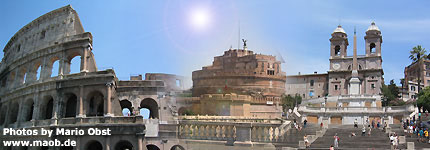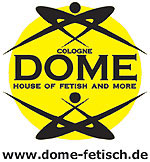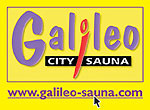|
Rome Community
Accommodation
Associations
Bars
Cinemas
Cruise & Men's Club
Dance Clubs
Disco
Events
Hotels

Internet Points
Locali Bar
Restauranti
Restaurants
Sauna
Saune
Sex Shops
Shopping
Travel
Viaggi
Special Map Vatican City
 Download Maps Download Maps
 Download Movies Download Movies









www.gaypower.info
www.centurio.com
www.gayhermes.com
www.matunda.de
www.gaysado.de
www.gaymaso.de
www.maob.com
www.nocreditcardgay.de
 


|


[english] [español] [français] [deutsch] [italiano]
Rome (Italy),...
... capital city of Italy and of Lazio (Latium) Region and Rome Province, on the Tiber River, in the central part of the country near the Tyrrhenian Sea. Vatican City, most of which is located in an enclave within Rome, is the seat of the papacy of the Roman Catholic church and has been recognized as an independent state by the Italian government since 1929. The majestic dome of Saint Peter’s Basilica in Vatican City dominates the Roman skyline.
For centuries, Rome has been called the Eternal City, a title earned through its importance as one of the great cities of Western civilization, as the capital of the Roman Empire, and as the world center of the Roman Catholic church
. Since 1871 it has been the capital of united Italy.
Only after World War II (1939-1945) was Rome’s status as the leading city of Italy again realized, as it overtook such major cities as Milan and Naples. Rome’s economy remains essentially based on two activities, government operations and tourism. The majority of the city’s workers are employed in these fields, in wholesale and retail trade, and in other service industries. In addition, Rome has become the site of the headquarters of many multinational corporations and agencies, including the United Nations Food and Agriculture Organization (FAO), International Fund for Agricultural Development (IFAD), and World Food Program.
Rome is a central point in Italy’s railroad system and also is connected by highway with many parts of the country. Leonardo da Vinci International Airport, situated near the seacoast, is one of the busiest in Europe. The city is served by a subway system.
According to tradition, Rome was founded in 753 bc on one of the Seven Hills—a term used for centuries to describe the Capitoline, Quirinal, Viminal, Esquiline, Caelian, Aventine, and Palatine hills surrounding the old community. Archaeological evidence indicates, however, that human settlement here dates from at least 1000 bc. The Capitoline Hill (Monte Capitoline) was long the seat of Rome’s government, and the Palatine Hill was the site of such great structures as the Palace of the Flavians, built by the Roman emperor Domitian. As a result of construction through the centuries, most of the Seven Hills are now hardly distinguishable from the adjacent plain. Other hills of Rome include the Pincian (Pincio) and the Janiculum.
Rome today is easily divided into two regions: the inner city, within the Aurelian Wall, built in the late 3rd century ad to enclose the area around the Seven Hills; and the sprawling outer city, with its suburbs. The historical center is a small area, located almost entirely on the eastern (left) bank of the Tiber. The monuments of Rome’s past greatness are, for the most part, within the historical center, in stark contrast to the modern districts. The street pattern of the city reflects its long and complex history. The Via del Corso traverses most of the historic center from the Piazza Venezia, the geographic center of Rome, to the Piazza del Popolo, at the foot of Pincio Hill. Its use dates from the Middle Ages, when it was a horse-racing course. The monument to Victor Emmanuel II, the first king of united Italy, built between 1895 and 1911, forms part of the Piazza Venezia. Other thoroughfares, such as the Via Vittorio Veneto, which commemorates Italy’s final victory in World War I (1914-1918) and is at the heart of the tourist area, were designed and built since the late 19th century. One of the largest public parks in Rome, the Pincio Gardens, lies on Pincio Hill, north of the historic center.
Rome has been an urban center for more than 2000 years, and although monuments of most periods of the city’s history still stand, the destructive impact of pollution and vibrations from heavy vehicular traffic is gradually leading to increased efforts toward preservation, including restrictions on cars and trucks in the historic center.
Rome is the site of Italy’s largest institution of higher education, the University of Rome (1303), which in the mid-1990s was attended by about 185,000 students. The Independent International University of Social Studies in Rome (1945) is also here.
In part because of its extraordinary wealth of artworks, Rome is a major world center for creative artists. Specialized schools of study in Rome include the Academy of Fine Arts, the National Academy of Dance, the National Academy of Dramatic Arts, the Santa Cecilia Conservatory of Music, and the Central Institute for the Restoration of Works of Art.
Rome plays a leading role in the creative and performing arts and in most other aspects of Italy’s cultural life. Opera is performed in the Opera House, one of the country’s best, and in the summer at the Baths of Caracalla. The city also has some 20 theaters and 6 major concert halls, which offer a varied repertory during the fall, winter, and spring.
The museums of the city deal with all aspects of the arts and sciences and are among the world’s finest. The oldest art collection in Rome, housed in the Capitoline Museum, was established in 1471 and contains exceptional antiquities. Among other Roman museums are the National Museum of the Villa Giulia, which has an outstanding collection of Etruscan and Roman art and is located in the mid-16th-century country house of Pope Julius III, and the Borghese Gallery, a museum of paintings and sculpture housed in an early 17th-century palace. The National Roman Museum, designed by Michelangelo, features exhibits of Greek and Roman sculpture, including the Ludovisi Collection of antiquities. Important collections of art and decorative pieces can also be seen in some of the city’s other palaces. Among these are the Farnese Palace, built between 1514 and 1589; the mid-15th century Venetian Palace, with a noted collection of small Renaissance bronzes; and the Palazzo Barberini, a 17th-century baroque palace with a remarkable picture gallery. See also Roman Art and Architecture.
According to legend, the city of Rome was founded by Romulus (with his brother, Remus, in some accounts) in 753 bc. Although archaeological evidence suggests earlier habitations on the site, extended human settlement may well have dated from this time. Traces of an Iron Age village from the mid-8th century bc have been found on the Palatine Hill. The legend of the rape of the Sabine women (see Sabines) and the subsequent merger of the Romans and Sabines are similarly supported by excavated remains.
Earliest Rome was a kingdom with two classes, the patricians (nobles) and the plebeians (commoners). The Senate, or Council of Elders, elected the monarchs and limited their power. For more detailed information on the early history of Rome, see Ancient Rome and Roman Empire.
Etruscan kings ruled Rome from the 7th to the late 6th century bc, but when the last monarch was overthrown, about 510 bc, a republic was established. Rome subsequently began to absorb the surrounding areas. After a Gallic invasion early in the 4th century bc, the so-called Servian Wall was built around the city. The first aqueduct in Rome was built in 312 bc. At the same time, the Via Appia (see Appian Way), connecting the city with southern Italy, was constructed. Rome continued to grow during and after the Punic Wars (264-146 bc). During that time the first basilica, a type of building that could accommodate crowds in bad weather, was constructed (184 bc) in the Forum.
After the assassinations (133 and 121 bc) of the brothers Tiberius and Gaius Gracchus, who had attempted to institute land reforms to aid the poor, the city experienced a period of instability that climaxed in the civil wars of the 1st century bc. Julius Caesar ultimately became dictator and instituted a series of reforms. The Forum had become crowded with structures and monuments and needed to be expanded; the Forum of Caesar was then planned. It was completed under Augustus, the first emperor, who also built the Forum of Augustus.
By the early imperial period, Rome was the hub of the Roman Empire, both physically, as the center of the Italian road system, and psychologically, as the capital of the world. This vast agglomeration had adequate water supply and efficient sewers, but the overcrowding of poor people in tenements resulted in frequent fires. Emperor Augustus instituted the vigiles, or fire fighters with police powers. In addition, vehicles were not allowed in the crowded streets except at night, and legislation was passed restricting the maximum height of buildings. A disastrous fire in ad 64 nevertheless destroyed much of the center of the city. For Nero, the emperor then in power, this was an opportunity to build his palatial Golden House.
The Flavian dynasty (ad 69-96), in order to gain favor with the Roman populace, began a program of public works. The most prominent of these was the amphitheater known as the Colosseum, which could accommodate gladiatorial games and even mock sea battles staged for huge crowds. Few or no large-scale industries existed in Rome at the time, and adequate employment was not available for the vast population; hence, the grain dole and games (bread and circuses) that had begun during Republican times continued. In addition to events in amphitheaters, chariot races were arranged in circuses and pantomimes in sumptuous theaters.
Emperor Trajan had the last of the imperial forums built in the early 2nd century. By that time, huge baths, some of them even including libraries, had become a fixture of the city’s life; the largest were built by Caracalla and Diocletian in the 3rd century. Because of the deterioration already threatening the empire, a wall was built around the city during the 3rd century. By the following century, however, it was clear that the imperial court would have to be closer to the borders. Emperor Constantine the Great therefore founded the city of Constantinople as the Christian “New Rome.” Although Rome then began to decline, the first major Christian basilicas, among them the original Saint Peter’s, were constructed during this period.
In 410 and 455 Rome was sacked by invading Germanic tribes. Attempts were made to preserve the physical plant of the city in the face of growing chaos, but occupation by the Ostrogoths in the 6th century, subsequent Byzantine reoccupation, and concomitant destruction all contributed to a precipitous decline, and the population dwindled. The city was, however, the seat of the papacy, and a certain number of people remained. Under Pope Gregory I the decline was even arrested for a while, but Italy later became a battleground again; in the 9th century a new low ebb was reached when Arabs attacked the area around the city, including the Vatican. During the Middle Ages, the built-up areas shrank until they were confined to the shore of the Tiber, where water was available. Only one of the ancient aqueducts was still operable.
Population (2001 estimate) 2,655,970
"Rome (Italy)," Microsoft® Encarta® Online Encyclopedia 2003
http://encarta.msn.com © 1997-2003 Microsoft Corporation. All Rights Reserved.
This edition is sponsored by
















|
